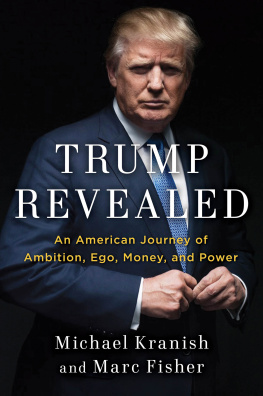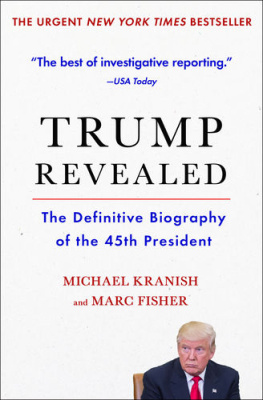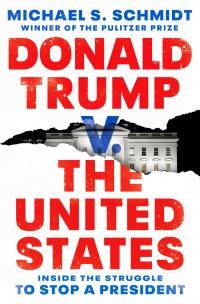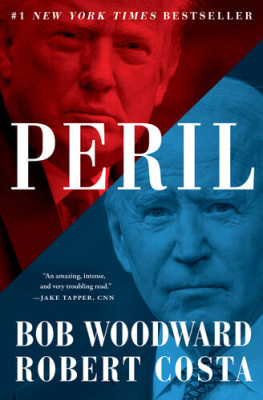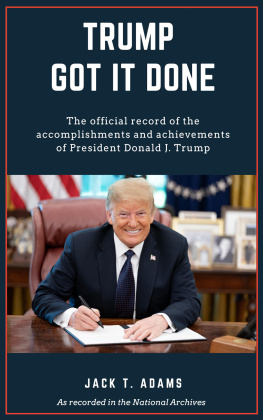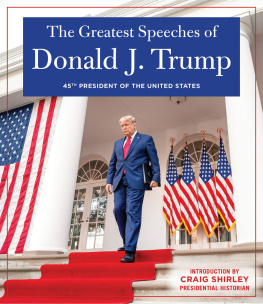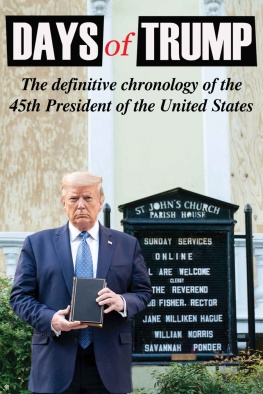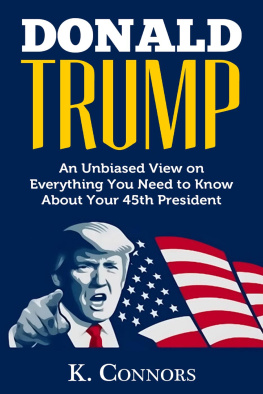CONTENTS
ABOUT THIS BOOK
Every four years, reporters at the Washington Post explore the lives and careers of the presidential nominees. The idea is to learn as much as possible about how the candidates think, decide, and act; to examine their past in order to glean how they might behave in the future. In late March 2016, with both parties nomination contests still unresolved, the Post s editors decided they had to get started on the extensive research and reporting necessary to produce comprehensive biographical studies of each candidate in the general election. Post editors assembled large teams of reporters to look into the work and backgrounds of the likely nominees, Donald Trump and Hillary Clinton. Both teams had the same charge, but Trump presented a unique challenge: he would be the first major party nominee for president in more than half a centurythe first since Dwight Eisenhowerto rise to that status without having held elective office.
The Post assigned more than twenty reporters, two fact-checkers, and three editors to examine Trumps life. In about three months, they were to produce this book and more than thirty articles for the Post , with the goal of chronicling and understanding everything from Trumps family background through his childhood, career, and political evolution. We sent reporters to his ancestral homes in Germany and Scotland, to his childhood neighborhood in Queens and his boarding school in upstate New York, to his college campuses in the Bronx and Philadelphia, and to his business ventures in Atlantic City, Panama, Russia, and Azerbaijan. We visited and spoke with Trumps relatives, classmates, friends, competitors, business partners, executives and employees, boosters, and critics.
This book is the work of an extraordinarily dedicated and talented group of reporters and editors: Jenna Johnson and Frances Sellers traveled far and wide to explore the Trump familys roots. Michael Miller and Paul Schwartzman reached back to Trumps childhood to find playmates, classmates, teachers, and neighbors. Robert OHarrow and Shawn Boburg explored Trumps complicated finances and real estate transactions in Atlantic City and New York, and Bob Woodward provided key interviews and guidance as we learned how Trump built his businesses. Drew Harwell traced the roots of the Trump Organization in Manhattan and Will Hobson delved into the evolution of Trumps decades-long love-hate relationship with the news media as well as his ventures in the world of professional sports. Mary Jordan and Karen Heller chronicled Trumps relationships with women, including his wives, girlfriends, and female executives. Amy Goldstein and Jerry Markon examined the ups and downs of Trumps casinos and other ventures during a particularly difficult stretch of his career, and Rosalind S. Helderman and Tom Hamburger traced how Trump reshaped his empire into a brand based on his name and popular image. Robert Samuels explored Trumps politics through the years and Kevin Sullivan traveled around the globe to examine the international ventures. Dan Balz went deep inside the 2016 campaign to understand how and why Trump emerged from the big pack of Republican candidates. Nearly all of these reporters also worked on other aspects of this book, which also benefited greatly from work by Post reporters Dan Zak, Ben Terris, Michael Birnbaum, Ian Shapira, Steve Hendrix, David A. Fahrenthold, Karen Tumulty, Robert Costa, Philip Rucker, and Janell Ross; researcher Alice Crites; and financial columnist Allan Sloan. Researchers Julie Tate and Lucy Shackelford painstakingly fact-checked the book, and photo editor Bronwen Latimer organized the books picture section. Editors Scott Wilson, Steven Ginsberg, and Peter Wallsten played a critical role in shaping the reporting and reading every draft as the process unfolded. The Post s executive editor, Martin Baron, and managing editor, Cameron Barr, were adamant from the start that this biography be as comprehensive and penetrating as possible, and they made an extraordinary commitment of resources to back that goal.
Trump made himself available for more than twenty hours of interviews with many of the reporters who worked on this book. He also made his lawyer and some members of his campaign staff available. He turned down our requests to speak to his siblings or to lift the restrictions hed imposed on his many current and former executives who signed nondisclosure agreements when they worked for Trump. He also declined to give us access to his income tax returns, something that every other presidential nominee in modern history has made available to the public. Throughout the process, Trump said he hoped and expected that this book would be accurate and fair, and we assured him that that was indeed our chief goal. At many points along the way, he also told us that if he didnt like the book, he wouldnt hesitate to denounce it or to take action against it. On the same day that he first agreed to be interviewed for this book, he told the New York Post that the project was ridiculous.
Donald Trump has lived by the credo that all attention, fawning or critical or somewhere in between, accrues to his benefit, that his personal image defines his brand, that he is his brand. We began this reporting on the theory that Trump, like anyone else, is far more than his reputation or brand. We conclude this work on that same note, having discovered that the man who would be president is far more complex than his simple language might indicate, that his motivations and values are informed by his parents, his upbringing, his victories and his defeats, and his lifelong quest for love and acceptance. What follows is the man we have come to know.
PROLOGUE
Presidential
H e was the front-runner now, and for his next act, he would become presidential. His son and his daughter and his wife had told him he had to do this, had to show his more thoughtful, calmer side. And he had told them, I can be very presidential. He had laughed and said, I can be more presidential than any president that this country has ever had, except for Abraham Lincoln, because... you cant out-top Abraham Lincoln. And now here he was, in the nations capital, in the belly of the beast, showing them all that he could do this. He would meet with a US senatora senator who was supporting him , the kid from Queens, the bad boy of New York real estateat the offices of one of the capitals top law firms. He would talk foreign policy with a roomful of Washington wonks. He would read a speech from a teleprompter, the tool hed long made fun of, the crutch that political losers used. He would name some of the insiders who would advise him in the White House, even though he would, of course, remain his own chief adviser, because he knew this stuff better than anyone else. On one crystalline spring day in 2016, the leader in the race for the Republican nomination for president of the United States would field whatever sharp questions the editorial board of the Washington Post might throw at him. Hed address the tough crowd at AIPAC, the American Israel Public Affairs Committee, one of the most influential lobbies in the most important city in the world, a group whose members were increasingly calling his campaign frightening, even demagogic. And just because he was in Washingtonwhere he was, by the way, building what would be one of his companys signature hotelshed lead the jackals of the media through the construction site, showing off the thick granite and the top-shelf marble. He would beam and jut his jaw as he announced that his hotel was coming in way ahead of schedule and under budget, and we have almost three hundred rooms, superluxury, and we are going to employ substantially more than five hundred people, at least five hundred people.

